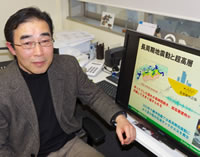Feature
Toyohashi Tech Earthquake Disaster Engineering Research: Protecting high-rise buildings from earthquakes
The huge Tohoku earthquake off the northeast coastline in March 2011 underscores the dangers of earthquakes in Japan. Such devastating earthquakes could occur anywhere in Japan. For example, anywhere along the Nankai Trough off the Pacific coast of central Japan that stretches for hundreds of kilometers to the southwest. Due to the meeting of three tectonic plates in the region, it is an active earthquake zone, and seismologists predict that a major quake will occur along this region by mid-century.
Notably, unlike many previous quakes, such as Kobe in 1995 that destroyed low rise buildings, the Nankai Trough quake is expected to cause great damage to high-rise buildings, oil tanks and suspension bridges in cities including Tokyo, Nagoya, and Osaka.
Most earthquakes last only a few seconds. But even such short shudders lead to the release of enormous energy as shock waves spreading out from the epicenter of the earthquake. When these waves reach the surface of the Earth they cause the ground to shake and set buildings in motion, starting from their foundations and rising up through the structures.
“Every building has its own natural frequency of vibration,” says Taiki Saito, a professor in Toyohashi Tech’s Department of Architecture and Civil Engineering, who is conducting research into earthquake resistant designs. “If the frequency of an earthquake’s shockwaves matches the frequency of a building then resonance takes place and damage results.” This, he adds, is what happened in the case of the Kobe earthquake, where the high frequency waves caused small, rigid buildings rather than taller flexible buildings to collapse.
“But Tokyo, Nagoya, and Osaka are located near deep layers of sediment,” says Saito. “Seismologists now know that such conditions can change the shock waves and create long period ground motions of low frequency even when far from a quake’s epicenter.” These low frequency waves can travel backwards and forwards through the sediment upon meeting hard obstacles like rock, creating ground movement that resonates with tall structures causing them to sway and topple.
Saito’s Earthquake Disaster Engineering Research Lab is investigating quake disaster mitigation for cities and high-rise buildings, including the development of a new type of damper that can be incorporated inside tall structures to absorb vibrations.
He is also deeply interested in promoting international cooperation to prevent damage from earthquakes, and has been working as a teaching expert with the Japan International Cooperation Agency (JICA). “Japan is most advanced in taking countermeasures against earthquakes and tsunami. It’s our duty to disseminate this knowledge and technology overseas.”
Currently, he is collaborating with Toyohashi Tech’s campus in Penang, Malaysia. “We are the only Japanese national university to have a campus abroad. And right now we are helping develop technology that can be applied to buildings in the region to protect them from earthquake damage—which is something else we are proud to be doing.”

Professor Taiki Saito
Enlarge Image


